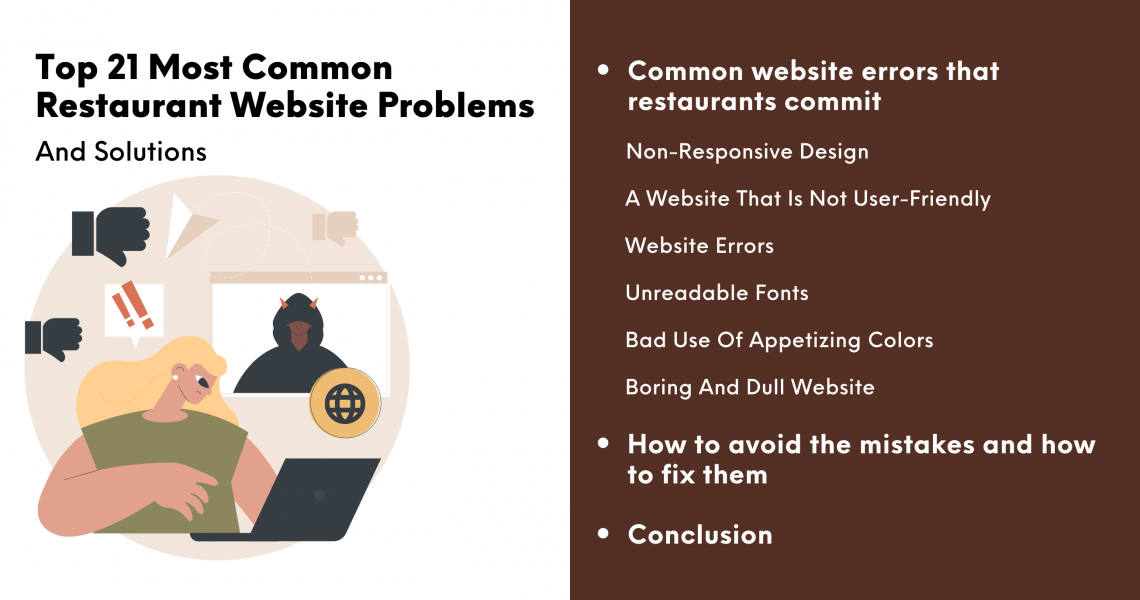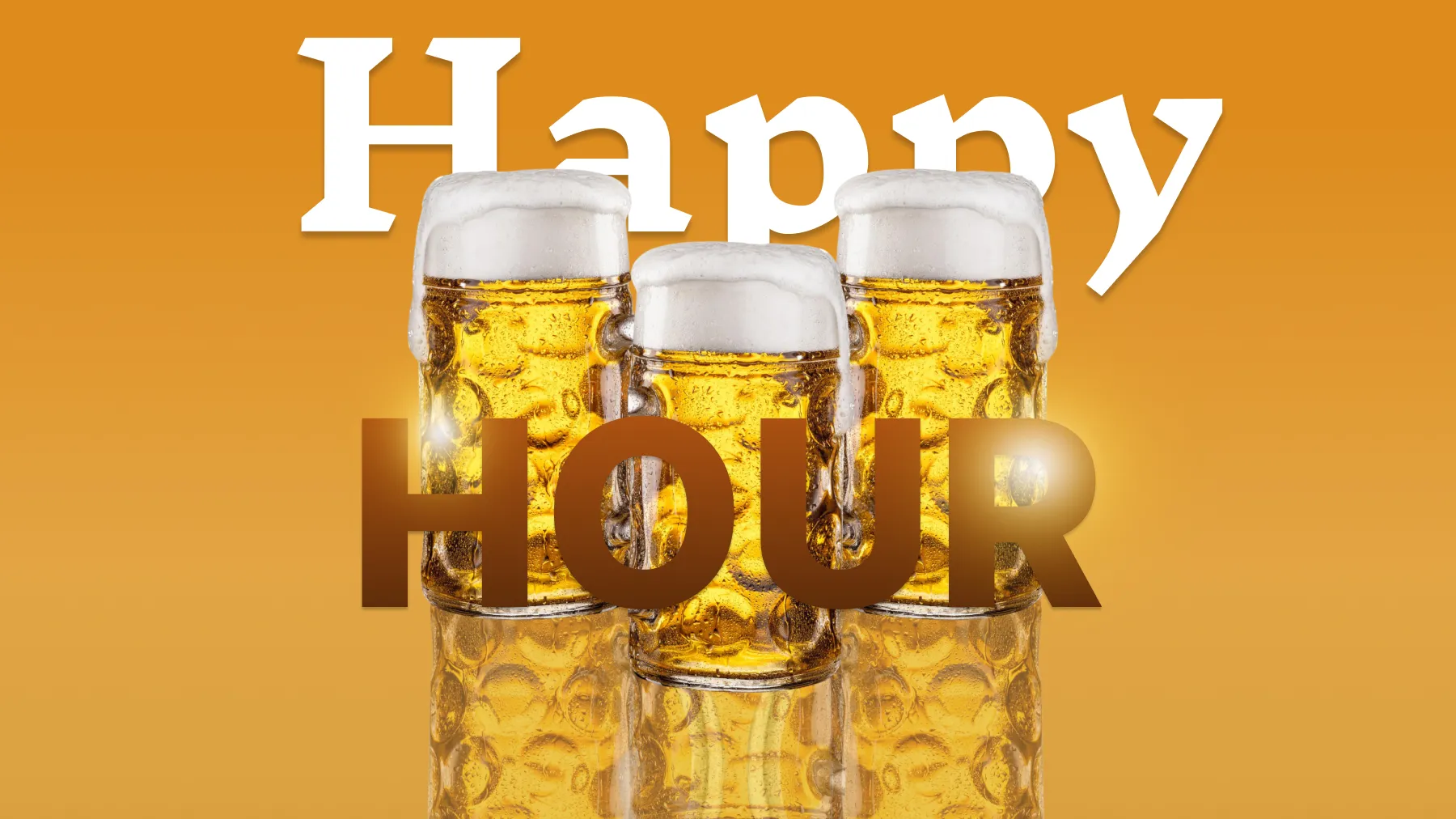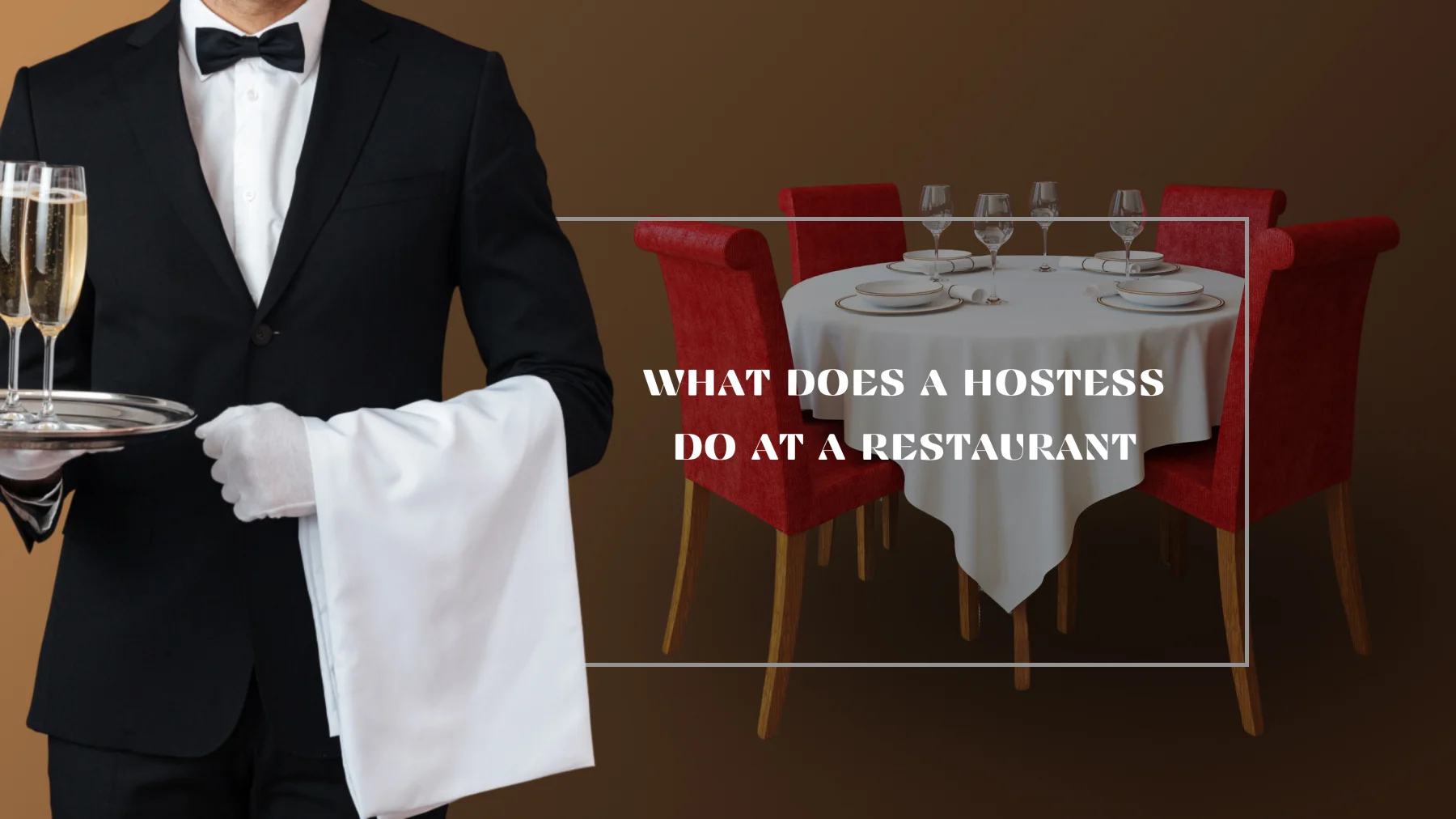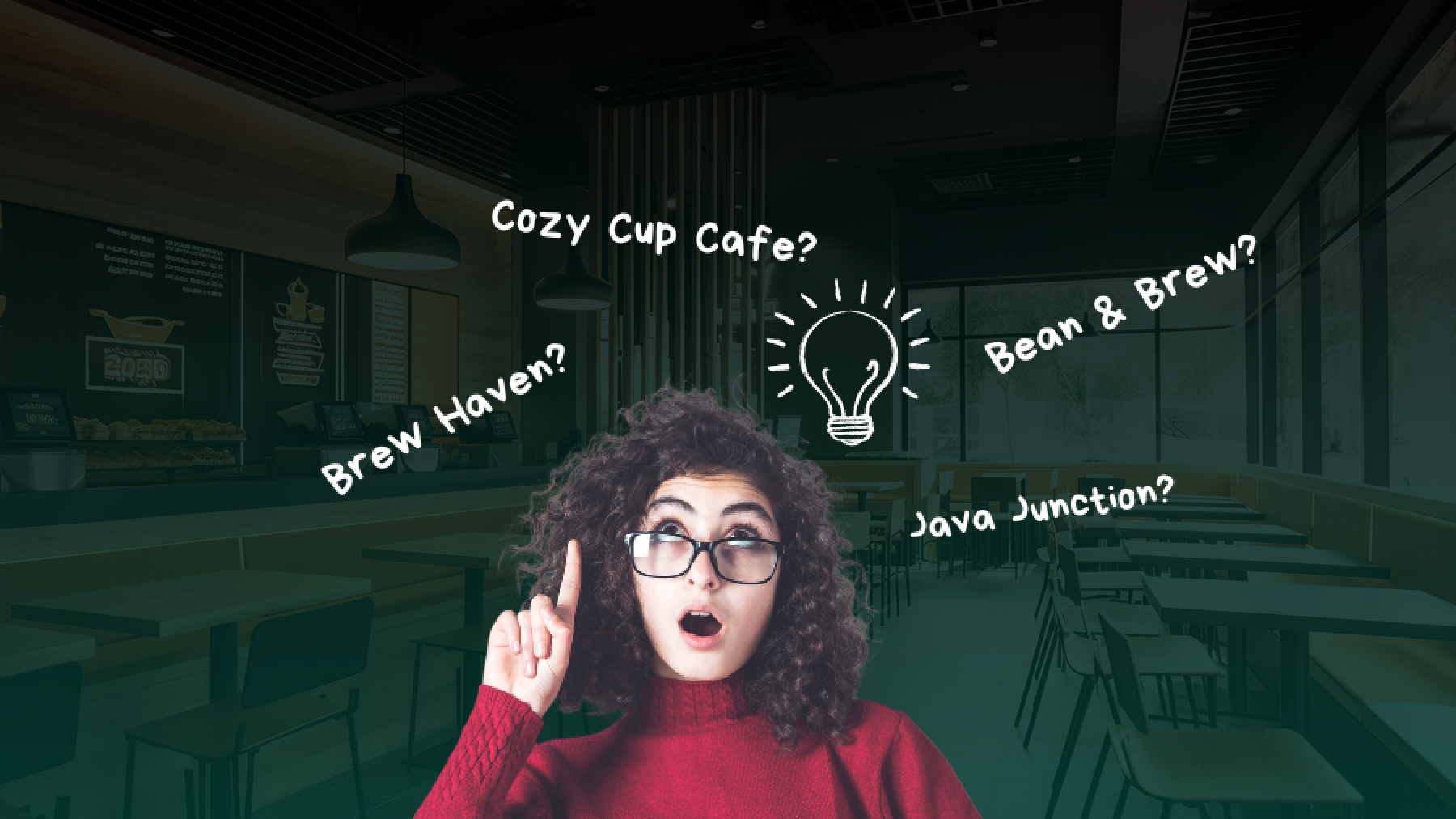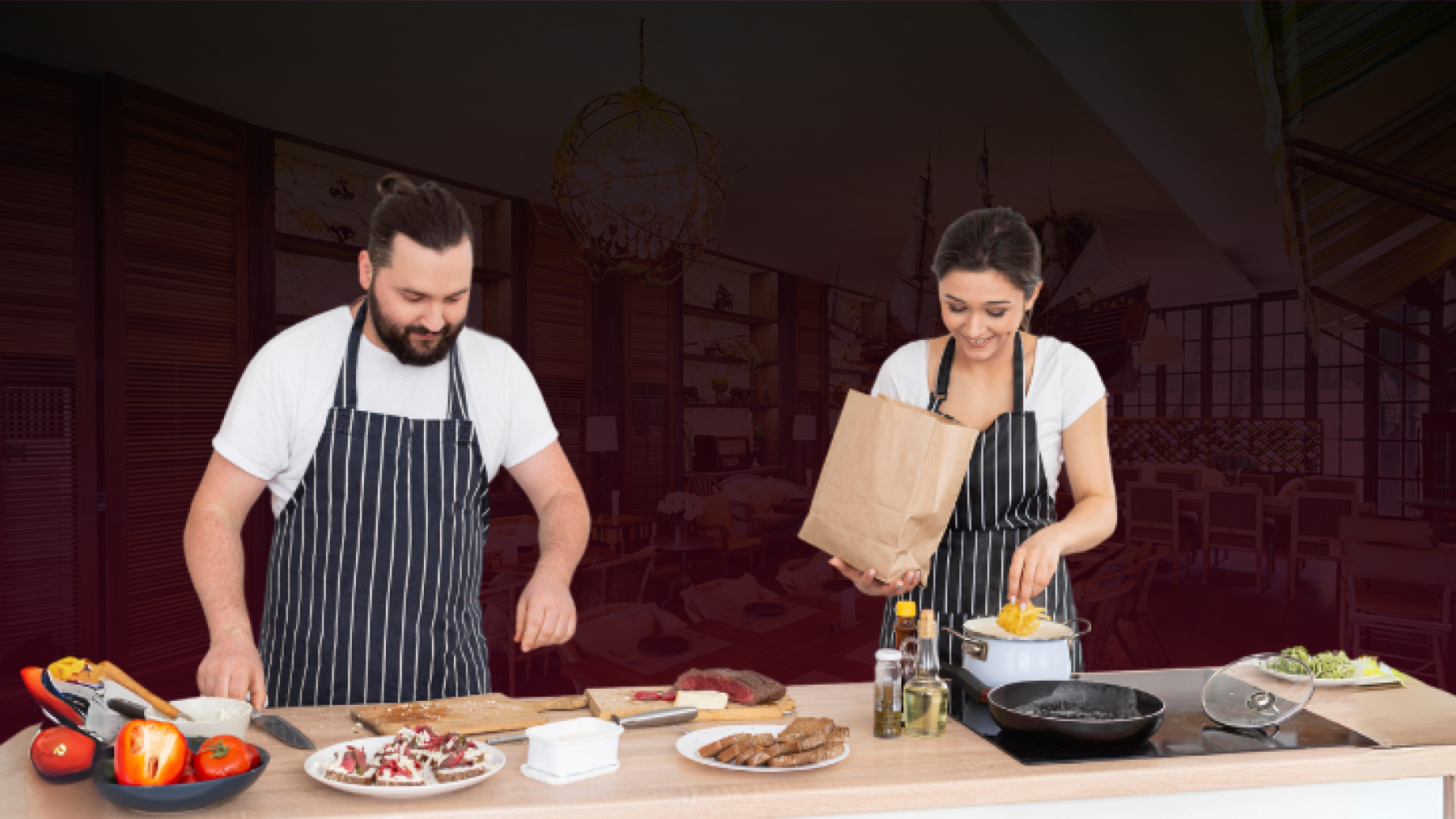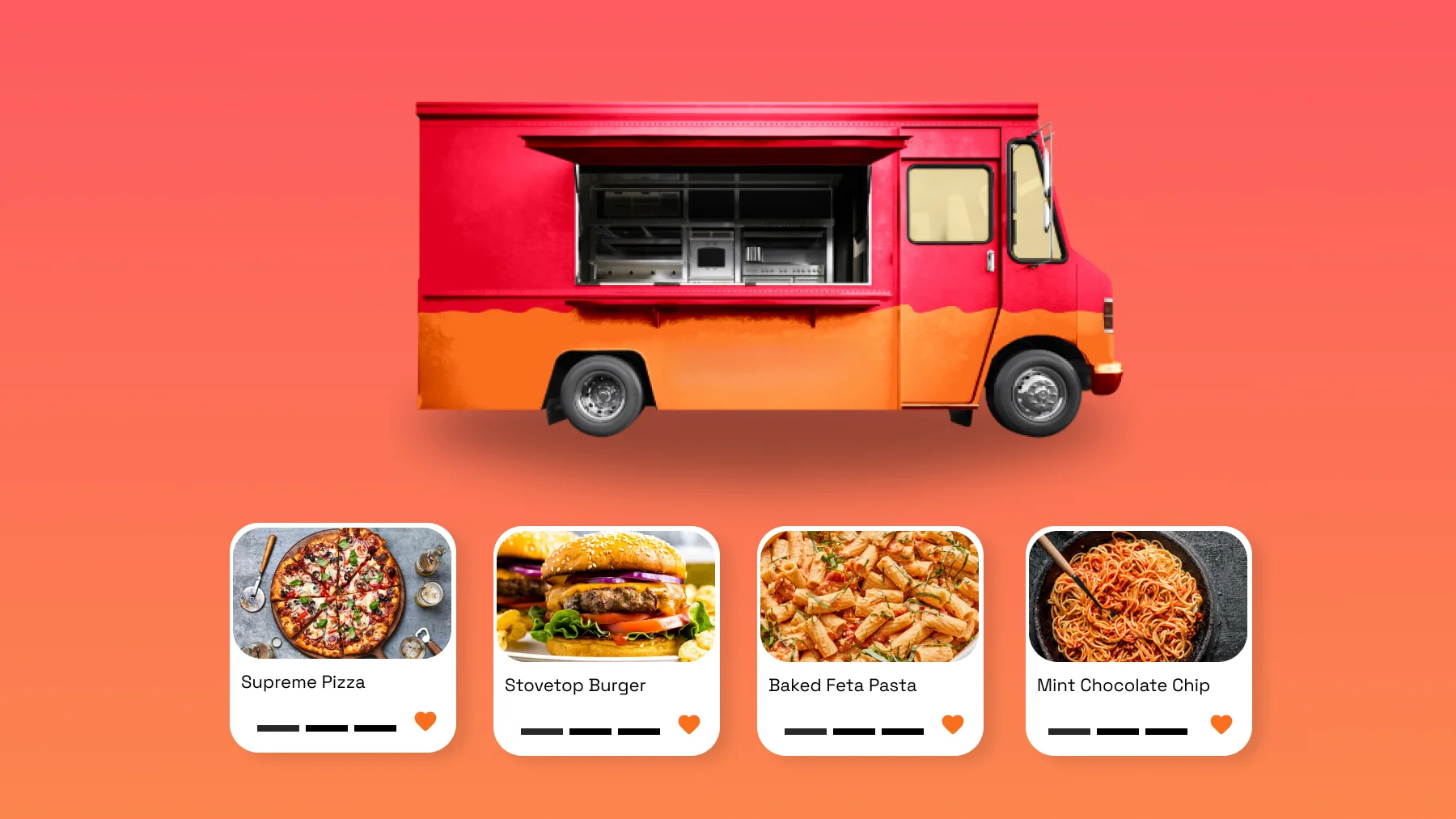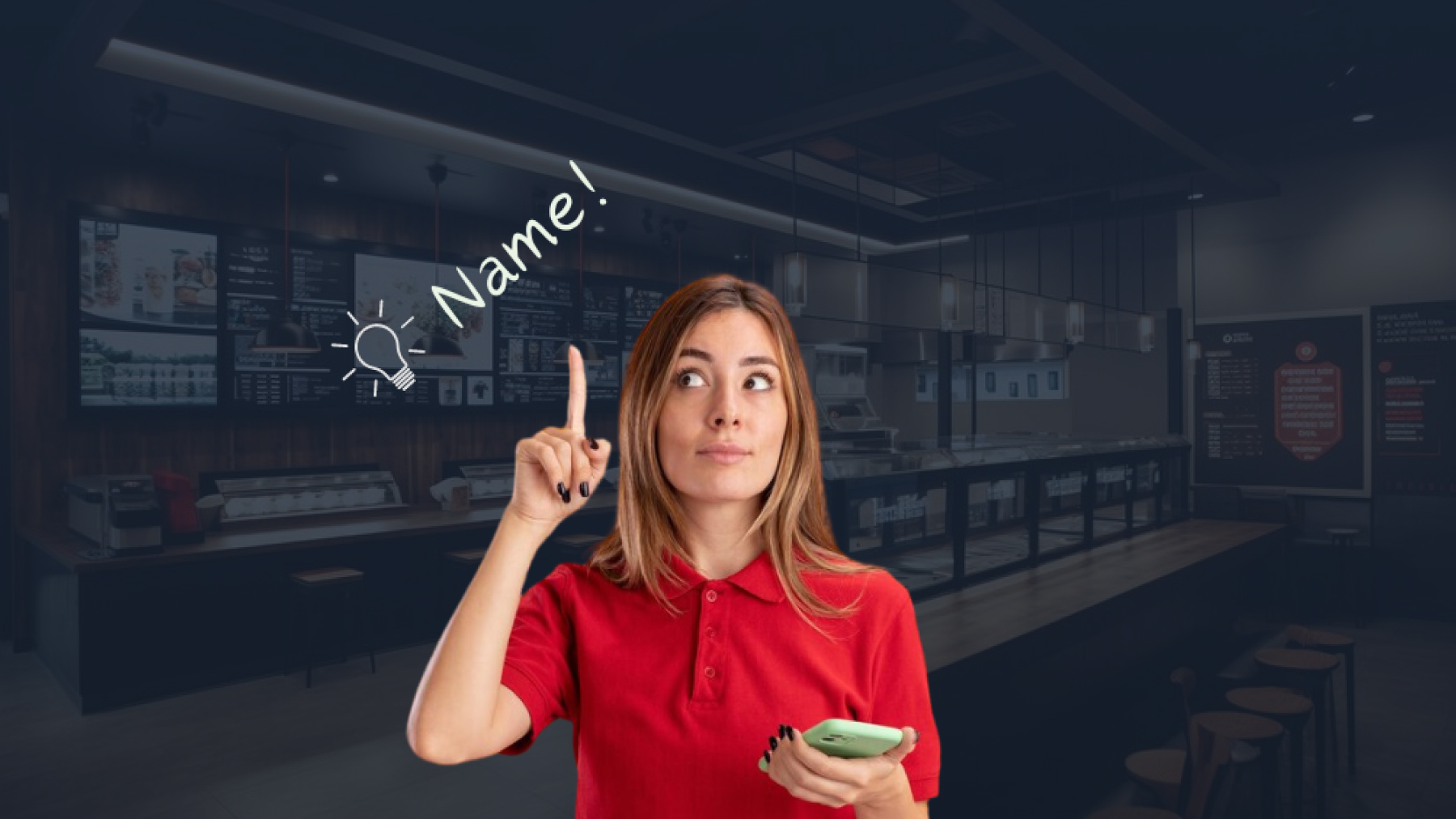Restaurant Website Mistakes That Restaurateurs Must Not Commit
The restaurant industry no longer needs to be told that having a website is essential for modern restaurant management and digital marketing. Statistics state that a whopping 77% of restaurant customers visit the restaurant website before deciding whether to dine-in or simply opt for delivery.
However, being online for the sake of it will not help the business in any way. One must not overlook the importance of survey results that state that 68% of diners choose another restaurant due to a restaurant’s website mistakes. Therefore, you need to create a restaurant website that looks professional and converts website visitors into financially rewarding customers.
Despite the availability of an ocean of social media options, (many of them being free too), the most valuable asset for a restaurant would be its own website. That is the place where communication must begin and that is the place where customers must be driven to. You might have created a website yourself or hired a professional’s help to get it done. Whichever way the website came into existence, it mustn't underperform in fulfilling the expectations of visitors.
Here is a list of common online pitfalls that prove to be hurdles for restaurants and stop them from realizing their maximum potential. Once you are done reading this article, you will be able to revamp your restaurant website to cater to the needs of today’s diners.
Common Website Errors That Restaurants Commit (And how to fix them)
1. Non-Responsive Design:
How bad is it to have a non-responsive website?
The answer is ‘REALLY BAD’.
Even excellent written content supplemented by beautiful images would turn out to be futile if the restaurant website is not easy for visitors to use. A site that requires the visitor to put in a lot of grueling effort will outright be rejected. This will be detrimental to the revenue of the restaurant business and ultimately, its growth. A challenging site is nothing but lost business.
The most important feature of a functional site is its responsiveness. Developing a fully responsive design allows multi-device users to enjoy visiting and being on your website, thus enhancing the user experience. A responsive website is also an important element of a good SEO strategy. Google ranks mobile-friendly websites at higher positions. While responsive websites are rewarded, the non-responsive ones lose the limelight.
2. A Website That Is Not User-Friendly:
Customers always prefer obtaining the ‘comfort’ quotient from every product and service that they use. That applies to online browsing too. When it comes to websites, this comfort gets another name – usability. It is bad usability that annoys visitors more than an outdated design. When they are not allowed to navigate a website with ease and waste a lot of time on mundane tasks, they have no choice but to leave. A website with a non-responsive design makes it anti-user-friendly.
For a positive user experience, make navigation intuitive, choose the color schemes carefully, pay attention to Call To Action, increase the website loading time speed, carefully listen to feedback from customers and users, and provide in-depth information in a clutter-free manner and strengthen up your contact page.
3. Website Errors:
There are several types of HTML errors that your website can pull, giving great frustration to website visitors. When people are engrossed in searching for nearby restaurants or a particular type of cuisine, and they encounter messages like 401 (Unauthorized), 403 (Forbidden), 404 (Not Found), 500 (Internal Server Error), 504 (Gateway Timeout), they are likely to renounce your restaurant website.
It is, therefore, important to fix such errors by reviewing the URL of the page that is causing such errors. The 404 (Not Found) error is likely to be seen by many people on a regular basis. This happens when a user tries to access a website that no longer exists. This error must be fixed by reviewing them using Google Search Console or submitting broken and redirected links in the website’s content management system.
4. Unreadable Fonts:
When you overdo on a copy, that too with unreadable fonts, you are committing a grave mistake. Fonts are crucial elements of design choices. They must be chosen meticulously while working on your brand identity. The best fonts help you bond instantly with the message and the brand while the worst fonts make you feel estranged.
Always consider whether the text is legible against the background used on the website. Also, make sure that the font size does not leave a strain on the visitor’s eye. hard-to-read text will always turn off visitors. So, choose typefaces that have even kerning (spaces between characters), consistency (serif or sans serif style applied not only to the alphabets but also to numbers and punctuation), balanced fonts (a balanced blend of thick and thin, heavy and light) and legible (easy to read). If a font cannot be read, the message remains locked on the website.
Check a font’s legibility by writing several words using it. Make sure that every letter and bunch of letter combinations are easy to read. Scale it up and down to see which size legibility becomes difficult and avoid using the typeface in that size. If you need very small text, use only a legible font.
5. Bad Use Of Appetizing Colors:
Wrong use of colors on a restaurant can drastically affect web traffic and the restaurant’s revenue. Using the contrast of two solid colors like red and green can prove heavy on the eye. Usage of neon colors increases inconvenience for user-interface elements. A white background will not work well with yellow and very pastel text. Using black in excess can also blackout the web. Usage of too many colors will also make the food less highlighted.
With the right use of colors on the restaurant website, customers are happy and their appetite is boosted. Several studies have shown that the red color helps to stimulate the appetite. This makes red a popular choice for food-based projects. Even if a red and green combo is necessary on the website, the monotony must be broken by using a contrasting color like white. Shades and Tints of colors must be used appropriately to highlight the food icons.
6. Boring And Dull Website:
Having a boring and dull-looking website is like having a flat tire. It will not take you anywhere. It will cause a negative impact on the diner causing them to drift away from the restaurant. Your potential customers will think – “If the restaurant website is so dull and boring, how can the food be interesting?” They will reject your brand without even actually knowing about it.
So, once you have decided to occupy a space for yourself online, make it as lively and interesting as possible. Capture the attention of visitors with images of food, your restaurant interiors, and even your chefs. Take them on a virtual tour of your cuisines and narrate your stories in a captivating manner that diners begin holding your brand close to their heart. Never allow the visitor to feel that they could have chosen some other brand over yours. Diligently use images, text, and other design-related layout elements to give them nothing short of a gripping website.
7. Food Menu That Is Not Accessible
When people walk into a restaurant and are not accommodated, it comes to the immediate notice of the restaurant manager or owner. But, when people leave restaurant websites due to inaccessible menus, no information about directions, hours of operation, and other basic information, restaurants will not be able to know about it.
The most important thing that any restaurant website visitor will look for is the menu. If this basic information is made inaccessible, hidden behind several layers of frivolous information, or requires several clicks for a first glance, the game is lost. It is important to highlight the menu right on the landing page and give every visitor instant access to the menu. Also, avoid uploading a PDF format of the menu as it will inhibit legibility and discourage people from making online food orders.
8. Not Sharing Basic Business Information:
When customers are on a restaurant’s website, they usually look for certain basic details or information. For example, address, phone number, operational timings, menu, and online food ordering or table reservation. When such basic information is not made available, diners will simply leave your website and choose the competitors. They definitely will not spend time on your website that lacks direction and details.
Once you have added these details check their accuracy and also if they are easy to locate on the website. Provide an ‘About Us’ or ‘Contact’ icon on the home page that will instantly be recognized by website visitors seeking valid information.
9. Poor Design And Website Template:
The design of a website directly impacts the user experience. Not paying attention to the design elements and the resulting website template can prove to be expensive for the restaurant business. With a poorly designed website or web template, visitors will not be able to complete any action, thus, leading to loss of valued clientele. If you are getting significantly low conversions and high bounce rates, it is time to evaluate the web design.
Make use of a user-friendly, clutter-free, and visually appealing design and template that gives you a brilliant online presence while also turning the profit wheel in your favor.
10. Poor Quality Images:
While perfect images can create magic through effective communication and help in brand building, bad images can make people instantly perceive you as ‘unprofessional’. Using images just for the sake of it even if it pixelated or distorted will make people abhor your brand and your perfunctory approach to getting the website done. They will think that this disinterest could be found in your food as well making them reject you forever.
Use high-quality images at all places on the website. By simply giving a glance at images of your recipes, people should begin to drool and wait to feast on it or order it right away. If you think you cannot click great pictures of your food, hire a professional who would be able to give you images that arouse the taste buds of visitors.
11. Slow Page Load Speed:
Statistics reveal that 50% of visitors leave a page that takes more than 3 seconds to load. When the loading time of the page is slow, restaurants lose current diners and future loyalists. As of now, the ideal page loading speed for Google is just 2 seconds. Any loading time above this mark should find you experiencing a negative impact on your Google ranking.
Increasing your page load speed is not rocket science. Start by making an evaluation of your website and its performance by using Google PageSpeed Insights or GTmetrix to get a breakdown of the elements that warrant immediate attention.
12. Not Providing Space For Customer Feedback:
When feedback from customers, food bloggers, or the press is not encouraged, people will stop communicating about your brand. Why would anyone want to leave reviews or ratings if the restaurant is not interested to hear about it? It is, therefore, important to provide spaces for customers and other food content producers to let the online world know their feedback, rate the website and the app, and recommend it to their near and dear ones. True testimonials lend great authenticity to your brand and its associated products and services. So, gather feedback meticulously and also display it with pride on your website.
13. Bad Navigation:
A bad design for a website’s navigation can bring everything to a screeching halt. It affects traffic, searches engine rankings, and ultimately, the success of a restaurant. Everything that is essential and important for a website is linked to the navigation – starting from the communicative content to the URLs.
Restaurant website visitors find it convenient to use horizontal navigation across the top or vertical navigation that is placed downwards on the left side. Putting the navigation bars on standard places increases the user-friendliness of a website, reduces the bounce rate, and also produces higher conversions. Always remember that navigation is not the place to introduce creativity. Provide people with everything even before they ask for it. The goal is to make people gain access to content and not show them a novel way of navigating a website.
14. Difficult Payment Options:
Ever since Covid-19 came into this world and people embraced the new normal, online payments and contactless payments have touched an all-time high. If restaurant website visitors are not provided with multiple payment options that are also easy to make payments, they would get frustrated and decline the order or empty the cart before exiting.
Contactless payments have gained more significance than online payments. Customers simply have to wave or tap their card over the restaurant’s POS system to complete their payment. There is no need to swipe the card or enter a PIN number. In less than one year, 56% of cards in the US market would turn contactless. So, restaurant websites must keep their online payment methods simple and also embrace the contactless mode for other financial transactions.
15. Absence Of Social Media Icons:
When visitors cannot find links to social media links on a restaurant’s website, they cannot verify further information about the restaurant. Their exploration about the restaurant and its food will stop with the Unless links are provided right on the website, Internet users will not take the strain to search for your brand name on other social media platforms. In order to provide depth to the quest of website visitors and diners, one must use the website much more than a static digital brochure.
Some restaurants avoid using social media links on the website, fearing that people might leave their page as soon as they land on it. But, it is important to realize that a restaurant website might well be the first place that diners visit. But, that could even be a result of a post that was published on a social media platform or any mention of your restaurant by a friend or follower. So, a restaurant website must be used as an information hub that connects visitors to all digital points where you maintain your presence.
By making the website an integral part of the chain of shared connections, you pave the way for people to be redirected to your social media pages. By making the website interactive, you also gain the opportunity of garnering traffic back to it from various social media platforms.
16. No Opportunity To Fetch Email Addresses:
If you are allowing people landing on your restaurant website to go away without getting their Email addresses, you are losing out on lead generation. People who are on your website are obviously those who are interested in your restaurant, the cuisine that you serve, etc. So, they would not mind sharing their email id and staying connected with you.
Whenever you have something new or interesting happening in your restaurant, you can inform such interested prospects about it through email. You can mail them newsletters periodically or communicate on an ad-hoc basis. The easiest and most inexpensive way to gather email ids is to enable a sign-up form on the restaurant website. People can be asked to type in their mail id and hit the subscribe button. Give diners some compelling reason to sign-up on your restaurant website. For example, offer first-time visitors a 25% discount on your food or a free drink. Such incentives will persuade them to sign up. While emailing people, include a line below the signature to promote your newsletter. Ask people to click the link and subscribe.
17. No Online Ordering Links:
If restaurants do not make use of the boom in the online food ordering industry, then they are sure to lose a significant amount of their revenue. People who visit a restaurant’s website are most often looking for options to order food right away. So, along with providing images of food and details of the menu, the restaurant must make appropriate facilities for diners to order food on the website.
This is not a food exhibition to simply present the food and stop with it. This is a business. So, every activity and effort must be based on generating revenue for the business. If the ordering link is absent or hidden behind layers of information, people will glance at the food and leave.
Online ordering and food delivery systems provide a clear channel of sales for restaurants. Customers will browse menu items, select recipes of their choice, place the order, and probably complete the transaction by making an online payment. Thus, providing distinct links for online ordering on the homepage of the restaurant website will initiate the CTA and bring the desirable revenue.
18. SEO Unfriendly:
Not being Search Engine Optimization (SEO) friendly is something that no business can afford today. Without good SEO practices in place, you lose the flow of traffic to your website and also the top spot of SERPs. You also lose the chance of being authorized and authenticated by search engines. With more than 90% of Internet users using mobile to access websites, not being SEO friendly affects your chances of giving mobile users a memorable user experience.
The best SEO practices will enhance the site speed and reduce latency for not only PC users but mobile users too. Providing content with no grammatical errors and well-optimized tags will ensure that the website is made SEO consistent. As a result of using keywords, you are rewarded with backlinks from high-quality sites.
19. Mobile Browser Incompatibility:
With thousands of devices having different screen sizes and resolutions being used by people globally, the chances of the site not getting rendered accurately on some screens are high. To avoid this, web developers must implement responsive design and also check the efficacy of this design on several real devices.
Cross-browser and cross-device compatibility are of high importance for all websites, particularly, restaurant websites. Mobile versions of websites must have easy navigation. The basic information that diners look for must be found upfront, preferably on the homepage itself. While all the information need not be accommodated on the first fold itself, a quick scroll should be able to give mobile users all necessary information.
20. No Table Reservation Link:
Without online table reservation links or forms, a restaurant makes people feel that the restaurant is not ready to entertain guests for dine-in service. The modality of table reservations helps restaurants in many ways. A restaurant can make accurate estimates of the food and space demand. They can arrange the required resources like food and staffing accordingly to serve the number of expected guests. With online reservations in place, the workflow can be managed in a better way and the restaurant will be able to effectively deliver a better quality of service.
Restaurants must provide an online table reservation link as it saves time, cuts costs, automates the booking process, reduces possible human errors, and results in high customer satisfaction.
21. No Address With Google Map:
People no longer rely on hand-held maps for travel directions or guidance. All they want is your location to be identified via Google Maps. If your Google Map location is not specified along with the postal address, people are not going to take the strain to ask for directions to your restaurant or try searching for it amidst busy streets.
Google Maps is not just used for navigation. It is also used as a search engine by users to locate businesses and restaurants that they are looking for. Once identified, Google Map is used to take people to their desired location. Clearly mentioning the Google Map location on the restaurant website is important as nearly 33% of all mobile device searches are connected to location (near me searches). This makes it evident that Google Map is a critical element for driving mobile traffic to your restaurant.
CONCLUSION
Having read about the 21 mistakes that restaurateurs must not commit, you will now be able to get yourself a website that turns the tide in your favor. Stay wary in the entire process of restaurant website creation so that you do not end up with a disastrous, ineffective website.
LATEST BLOG POST
What Is Happy Hour? 10 Foolproof Ways to Make Your Happy Hour Successful
ShareTweetSharePin0 Shares
What does a hostess do at a restaurant? Duties And Responsibilities
ShareTweetSharePin0 Shares
200 + Cafe Name Ideas That Will Make Your Business Stand Out
ShareTweetSharePin0 Shares
How to Craft an Effective Restaurant Mission Statement: A Step-by-Step Guide
ShareTweetSharePin11 Shares
How to Create Food Truck Business Plan? Complete Guide
ShareTweetSharePin11 Shares
How to Choose the Right Restaurant Name (+ 190 Great Ideas & Examples)
ShareTweetSharePin11 Shares
